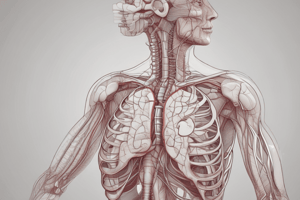Podcast
Questions and Answers
How does an increase in pressure gradient affect flow rate?
How does an increase in pressure gradient affect flow rate?
- It increases viscosity
- It decreases flow rate
- It has no effect on flow rate
- It increases flow rate (correct)
What effect does vasoconstriction have on flow?
What effect does vasoconstriction have on flow?
- It increases flow
- It decreases flow (correct)
- It increases resistance
- It has no effect on flow
How does the vessel radius affect resistance and flow?
How does the vessel radius affect resistance and flow?
- Vessel radius has no effect on resistance and flow
- A bigger radius increases viscosity
- A bigger radius increases resistance and decreases flow
- A bigger radius decreases resistance and increases flow (correct)
Which process drives absorption in capillary exchange?
Which process drives absorption in capillary exchange?
What regulates vessel constriction and dilation based on action potential frequency?
What regulates vessel constriction and dilation based on action potential frequency?
What is the primary function of the lymphatic system?
What is the primary function of the lymphatic system?
Which of the following is the correct formula for calculating stroke volume?
Which of the following is the correct formula for calculating stroke volume?
What is the formula for calculating cardiac output?
What is the formula for calculating cardiac output?
Which of the following factors influences stroke volume?
Which of the following factors influences stroke volume?
What is the relationship between velocity and flow rate in a tube?
What is the relationship between velocity and flow rate in a tube?
What is the main reason for the longer refractory period of cardiac cells compared to skeletal muscle cells?
What is the main reason for the longer refractory period of cardiac cells compared to skeletal muscle cells?
What characterizes the action potential of a cardiac autorhythmic cell?
What characterizes the action potential of a cardiac autorhythmic cell?
What is the primary function of the pleural sac?
What is the primary function of the pleural sac?
Which cells in the alveolar sac are responsible for respiration?
Which cells in the alveolar sac are responsible for respiration?
According to Dalton’s law, what does the sum of partial pressures in a container equal?
According to Dalton’s law, what does the sum of partial pressures in a container equal?
Flashcards are hidden until you start studying
Study Notes
Respiratory and Circulatory System Processes
- Iron ingested from diet and absorbed by active transport
- Transferrin protein transports iron in plasma to either liver for storage or bone marrow for hemoglobin formation
- Hemostasis steps: vasoconstriction, platelet plug formation, clot formation
- Primary functions of respiratory system: gas exchange, pH regulation, protection, vocalization
- Pleural sac importance: double-layered membrane around lungs, prevents friction, maintains lung inflation
- Alveolar sac cells: type 1 for respiration, type 2 secretes surfactant, alveolar macrophage for immunity
- Respiratory membrane components: alveolar type 1 cell, basement membrane, pulmonary capillary endothelium
- Pulmonary circulation pathway: right ventricle, pulmonary trunk, arteries, capillaries, venules, veins, left atrium
- Mucociliary escalator: traps and removes pathogens, involving mucus, saline layer, and cilia
- Dalton’s law: sum of partial pressures in a container equals total gas pressure
- Boyle’s law in respiratory system: volume changes inversely affect pressure
- Lung volumes and capacities definitions and calculations: TV, IRV, ERV, RV, IC, FRC, VC, TLC
- Pressure changes in lungs during quiet breathing: intrapleural and alveolar pressure fluctuations, volume changes
Studying That Suits You
Use AI to generate personalized quizzes and flashcards to suit your learning preferences.




